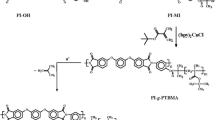Abstract
Purpose.
In an effort to expand the application of core-shell structures fabricated by electrostatic layer-by-layer (LbL) self-assembling for drug delivery, this study reports the controlled release of dexamethasone from microcrystals encapsulated with a polyelectrolyte shell.
Methods.
The LbL self-assembly process was used to produce dexamethasone particles encapsulated with up to five double layers formed by alternating the adsorption of positively charged poly(dimethyldiallyl ammonium chloride), negatively charged sodium poly(styrenesulfonate) and depending on the pH positively or negatively charged gelatin A or B onto the surface of the negatively charged dexamethasone particles. The nano-thin shells were characterized by quartz crystal microbalance measurements, microelectrophoresis, microcalorimetry, confocal microscopy, and scanning electron microscopy. In vitro release of dexamethasone from the microcapsules suspended in water or carboxymethylcellulose gels were measured using vertical Franz-type diffusion cells.
Results.
Sonication of a suspension of negatively charged dexamethasone microcrystals in a solution of PDDA not only reduced aggregation but also reduced the size of the sub-micrometer particles. Assembly of multiple polyelectrolyte layers around these monodispersed cores produced a polyelectrolyte multilayer shell around the drug microcrystals that allowed for controlled release depending on the composition and the number of layers.
Conclusions.
Direct surface modification of dexamethasone microcrystals via the LbL process produced monodispersed suspensions with diffusion-controlled sustained drug release via the polyelectrolyte multilayer shell.
Similar content being viewed by others
References
1. G. Decher. Fuzzy nanoassemblies: toward layered polymeric multicomposites. Science 227:1232–1237 (1997).
2. Y. M. Lvov, G. Decher, and H. Möhwald. Assembly, structural characterization and thermal behaviour of layer-by-layer deposited ultrathin films. Langmuir 9:481–486 (1993).
3. Y. M. Lvov, K. Ariga, I. Ichinose, and T. Kunitake. Assembly of multicomponent protein films by means of electrostatic layer-by-layer adsorption. J. Am. Chem. Soc. 117:6117–6123 (1995).
4. J. Mendelsohn, C. Barrett, V. Chan, A. Pal, A. Mayes, and M. Rubner. Fabrication of microporous thin films from polyelectrolyte multilayers. Langmuir 16:5017–5023 (2000).
5. B. Tieke, F. van Ackern, L. Krasemann, and A. Toutianoush. Ultrathin self-assembled polyelectrolyte multilayer membranes. Eur. Phys. J. E 5:29–39 (2001).
6. X. Qui, S. Leporatti, E. Donath, and H. Möhwald. Studies on the drug release properties of polysaccharide multilayers encapsulated ibuprofen microcrystals. Langmuir 17:5375–5380 (2001).
7. H. Ai, S. A. Jones, M. M. de Villiers, and Y. M. Lvov. Nano-encapsulation of furosemide microcrystals for controlled drug release. J. Control. Rel. 86:59–68 (2003).
8. D. B. Sheney and G. B. Sukhorukov. Engineered microcrystals for direct surface modification with layer-by-layer technique for optimized dissolution. Eur. J. Phar. Biopharm 58:521–527 (2004).
9. Y. M. Lvov, A. Antipov, A. Mamedov, A Möhwald, and G. Sukhorukov. Urease encapsulation in nanoorganized microshells. Nano Lett. 1:125–128 (2001).
10. Y. M. Lvov and F. Caruso. Biocolloids with ordered urease multilayer shells as enzymatic reactors. Anal. Chem. 73:4212–4217 (2001).
11. G. Ibarz, L. Dahne, E. Donath, and H. Möhwald. Smart micro- and nanocontainers for storage, transport, and release. Adv. Mater. 13:1324–1327 (2001).
12. I. Suzuki, T. Ishizaki, H. Ihoue, and J. Anzai. Modification of polyelectrolyte layered assembly using an active ester of azobenzene carboxylate. Macromolecules 35:6470–6474 (2002).
13. G. B. Sukhorukov, A. A. Antipov, A. Voigt, E. Donath, and H. Möhwald. pH-controlled macromolecule encapsulation in and release from polyelectrolyte multilayer capsules. Macromol. Rapid Commun. 22:44–46 (2000).
14. A. A. Antipov, G. B. Sukhorukov, S. Leporatti, I. L. Radtchenko, E. Donath, and H. Möhwald. Polyelectrolyte multilayer capsule permeability control. Coll. Surf. A: Physicochem. Eng. Aspects 198–200:535–541 (2002).
15. Z. Sui, D. Salloum, and J. B. Schlenoff. Effect of molecular weight on the construction of polyelectrolyte multilayers: stripping versus sticking. Langmuir 19:2491–2495 (2003).
16. A. A. Antipov, G. B. Sukhorukov, E. Danoth, and H. Möhwald. Sustained release properties of polyelectrolyte multilayer capsules. J. Phys. Chem. B 105:2281–2284 (2001).
17. G. B. Sukhorukov, E. Danoth, E. Moya, S. Susha, A. Voigt, A. Hartmann, and H. Möhwald. Microencapsulation by means of step-wise adsorption of polyelectrolytes. J. Microencapsul. 17:177–185 (2000).
18. O. P. Tiourina and G. B. Sukhorukov. Multilayer alginate/protamine micronized capsules: encapsulation of |ga-chymotrypsin and controlled release study. Int. J. Pharm. 242:155–161 (2002).
19. G. B. Sukhorukov, E. Donath, S. Davis, H. Lichtenfeld, F. Caruso, V. I. Popov, and H. Möhwald. Step-wise polyelectrolyte assembly on particle surfaces-a novel approach to colloid design. Polym. Adv. Technol. 9:759 (1998).
20. Martindale. The Extra Pharmacopoeia, 30th ed. The Pharmaceutical Press, London, 1993.
21. The United States Pharmacopeia XXVI and National Formulary 19. The United States Pharmacopeial Convention, Bethesda, MD, USA, 2000.
22. N. A. Peppas. Analysis of Fickian and non-Fickian drug release from polymers. Pharm. Acta Helv. 60:110–111 (1985).
23. R. W. Baker. Controlled Release of Biologically Active Agents, John Wiley & Sons, New York (1987).
24. M. T. Record, M. L. Lohman, and P. De Haseth. Ion effects on ligand-nucleic acid interactions. J. Mol. Biol. 107:145–158 (1976).
25. V. Ball, M. Winterhalter, P. Schwinte, P. Lavalle, J. C. Vogel, and P. Schaaf. Complexation mechanism of bovine serum albumin and polly(allylamine hydrochloride). J. Phys. Chem. B 106:2357–2364 (2002).
26. M. Bezan, M. Malavasic, and G. Vesnaver. Surfactant binding to oppositely charged polyions. Berichte der Bunsen-Gesellschaft 100:1054–1058 (1996).
27. C. Wang and K. C. Tam. Interaction between polyelectrolyte and oppositely charged surfactant: effect of charge density. J. Phys. Chem. B 108:8976–8982 (2004).
28. H. Eroglu, H. S. Kas, L. Oner, O. F. Turkoglu, N. Akalan, M. F. Sargon, and N. Ozer. The in-vitro and in-vivo characterization of PLGA: L-PLA microspehere containing dexamethasone sodium phosphate. J. Microencap. 15:603–612 (2001).
29. H. Kim, H. W. Kim, and H. Suh. Sustained release of ascorbate-2-phosphate and dexamethasone from porous PLGA scaffolds for bone tissue engineering using mesenchymal stem cells. Biomaterials 24:4671–4679 (2003).
Author information
Authors and Affiliations
Corresponding author
Rights and permissions
About this article
Cite this article
Pargaonkar, N., Lvov, Y., Li, N. et al. Controlled Release of Dexamethasone from Microcapsules Produced by Polyelectrolyte Layer-by-Layer Nanoassembly. Pharm Res 22, 826–835 (2005). https://doi.org/10.1007/s11095-005-2600-0
Received:
Accepted:
Published:
Issue Date:
DOI: https://doi.org/10.1007/s11095-005-2600-0




